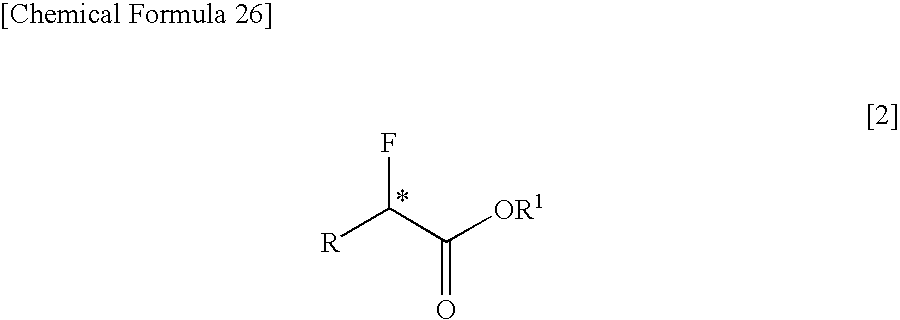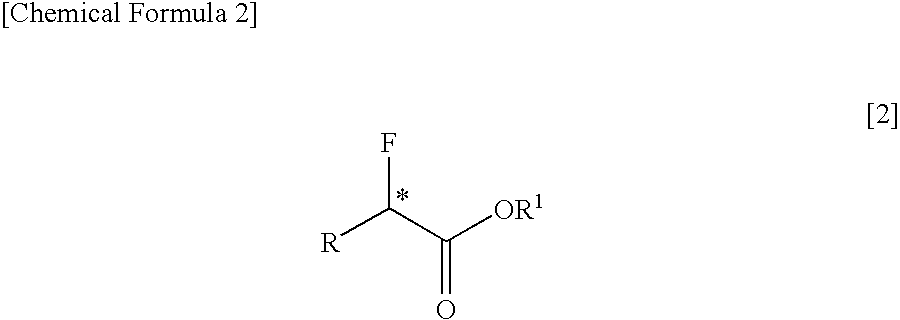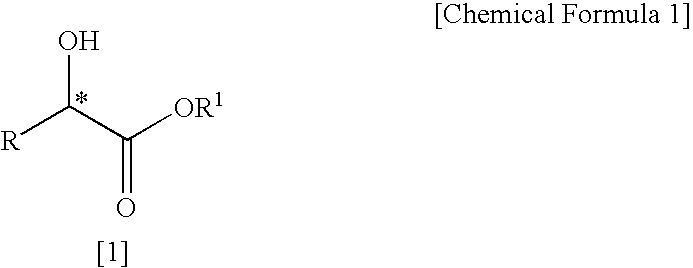Process For Production Of Optically Active Alpha-Fluoro-Carboxylic Ester Derivatives
a technology of fluorocarboxylic ester and process, which is applied in the preparation of hydroxy compounds, chemistry apparatus and processes, and organic chemistry, etc., can solve the problems of high price, high price, and danger of large amount of use of -fluorocarboxylate derivatives, and achieve low price
- Summary
- Abstract
- Description
- Claims
- Application Information
AI Technical Summary
Benefits of technology
Problems solved by technology
Method used
Image
Examples
example 1
[0058]A pressure-proof reaction vessel made of stainless steel (SUS) was charged with 137.00 g (1159.74 mmol, 1.00 eq, optical purity: 98.5% ee) of an optically active α-hydroxycarboxylate derivative represented by the following formula,
380 ml of mesitylene, and 120.10 g (1186.88 mmol, 1.02 eq) of triethylamine, followed by lowering the inside temperature to around −40° C. and bubbling 208.80 g (1373.05 mmol, 1.18 eq) of trifluoromethanesulfonyl fluoride from a cylinder. With stirring, it was returned to room temperature by spending about 4 hours, and furthermore stirring was conducted at room temperature for about 15 hours. Conversion of the reaction was found by gas chromatography measurement to be 99.8%. The reaction-terminated liquid separated into two layers was poured into 1,200 ml of 10% potassium carbonate aqueous solution to wash the organic layer. The recovered organic layer was washed with 1,400 ml of 1N hydrogen chloride aqueous solution and then 400 ml of 10% calcium ch...
example 2
[0061]A tetrahydrofuran solution (the amount of tetrahydrofuran used: 160 ml) containing 97.97 g (chemical purity: 96.3%, 785.42 mmol, 1.00 eq) of an optically active α-fluorocarboxylate derivative represented by the following formula,
was gradually added to a tetrahydrofuran solution (the amount of tetrahydrofuran used: 630 ml) containing 22.70 g (598.00 mmol, 0.76 eq) of aluminum lithium hydride under cooling with ice, while controlling the inside temperature to 10° C. or lower, followed by stirring at the same temperature for 20 minutes and furthermore stirring at room temperature for 2 hours and 10 minutes. Conversion of the reaction was found by gas chromatography measurement to be 100%. Sodium sulfate decahydrate was gradually added to the reaction-terminated liquid under cooling with ice, while controlling the inside temperature to 12° C. or lower to mostly decompose aluminum lithium hydride used excessively. Furthermore, stirring was conducted for about 1 hour, while adding s...
example 3
[0062]A pressure-proof reaction vessel made of stainless steel (SUS) was charged with 2.00 g (9.60 mmol, 1.00 eq, optical purity: 99.2% ee) of an optically active α-hydroxycarboxylate derivative represented by the following formula,
10 ml of toluene and 2.00 g (19.76 mmol, 2.06 eq) of triethylamine, followed by immersing the reaction vessel into a dry ice / acetone bath of −78° C., bubbling 3.00 g (19.73 mmol, 2.06 eq) of trifluoromethanesulfonyl fluoride from a cylinder, immediately transferring into an iced bath, and stirring for 1 hour. Conversion of the reaction was found by gas chromatography measurement to be 100%. The reaction-terminated liquid was poured into a saturated sodium hydrogencarbonate aqueous solution, followed by extraction with toluene. The recovered organic layer was dried with anhydrous sodium sulfate, followed by filtration, thereby obtaining 2.18 g of a crude product of an optically active α-fluorocarboxylate derivative represented by the following formula.
The ...
PUM
| Property | Measurement | Unit |
|---|---|---|
| carbon number | aaaaa | aaaaa |
| boiling point | aaaaa | aaaaa |
| optical purity | aaaaa | aaaaa |
Abstract
Description
Claims
Application Information
 Login to View More
Login to View More - R&D
- Intellectual Property
- Life Sciences
- Materials
- Tech Scout
- Unparalleled Data Quality
- Higher Quality Content
- 60% Fewer Hallucinations
Browse by: Latest US Patents, China's latest patents, Technical Efficacy Thesaurus, Application Domain, Technology Topic, Popular Technical Reports.
© 2025 PatSnap. All rights reserved.Legal|Privacy policy|Modern Slavery Act Transparency Statement|Sitemap|About US| Contact US: help@patsnap.com



